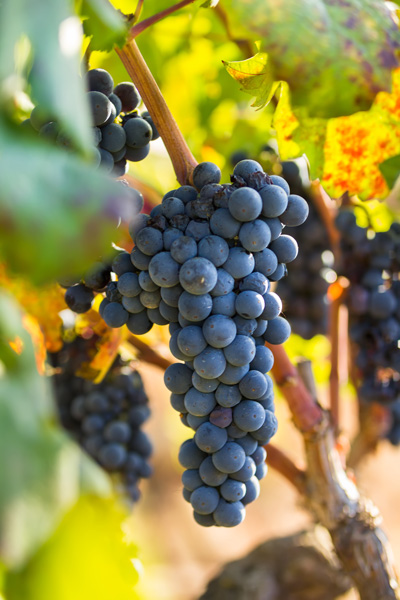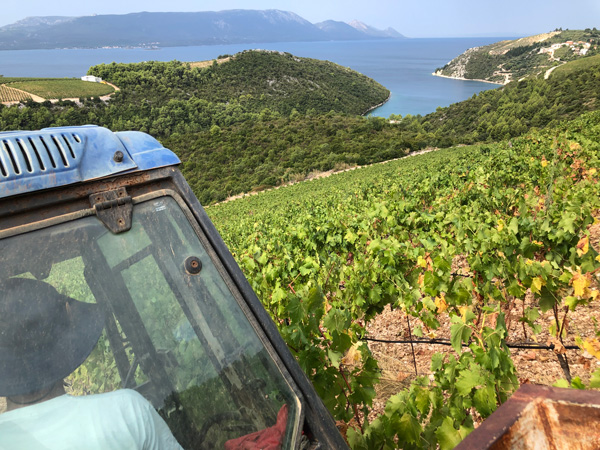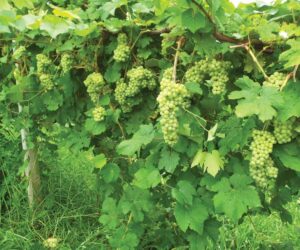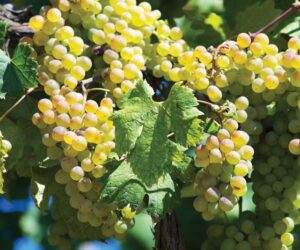
Getting inspired to write about grape varieties sometimes requires a trip down memory lane, and realizing just how long I have been writing this column. This reflection goes back now almost ten years to the day when I started off a column with the words “Zinfandel, America’s grape!” Not wanting to plagiarize myself, I read through the column and then reflected on the resources I have used over the years to compile information on the many columns I have produced.
That column was certainly not inspired by my now most favorite resource since this book was first copyrighted in 2012. The book is Wine Grapes: A complete guide to 1,368 vine varieties, including their origins and flavors. The lead author being Jancis Robinson, a British wine critic, journalist, and wine writer who I actually had the opportunity to meet some years ago. Her knowledge of grape varieties is so extensive that ever since I purchased the book, that’s where I go first.
I opened the book to this issue’s subject, Primitivo, thinking there would be pages of information, and saw a reference to a variety I had never heard of. I then thought, what about Zinfandel? In my circle, I knew that Primitivo and Zinfandel were genetically identical. So I turned to almost the last page, and it referenced the same, apparently to me, obscure variety. Can you guess this mystery varietal’s name? Okay, time’s up. The variety’s name is Tribidrag and it’s the variety that will draw the line to connect the dots for those fans of Zinfandel and Primitivo.
The Back Story
Tribidrag is the oldest and original name for this red grape variety, which traces its roots to the Dalmatian Coast in Croatia. In Italy it is better known as Primitivo while across the ocean in North America it is most commonly referred to as Zinfandel. But how it came to be called Primitivo then later Zinfandel, is the intriguing part of this grape’s story.
But where the grape varietal spread extensively was in the heel of Italy, the Puglia region, just to the northeast.
The earliest mention of Primitivo dates to southern Italy in 1799 when an amateur botanist and agronomist made a note in his village’s records that he had found an early ripening variety, that he would call Primativo, (note the spelling), from the Latin word primativus, which translates to first to ripen. Before Primativo, it was known as Zagarese (apparently from Zagreb, Croatia) or Zagarolese, a name given to plantings of the same variety in Calabria, in the toe of southern Italy. But where the grape varietal spread extensively was in the heel of Italy — the Puglia region, just to the northeast. The current spelling using the “i” rather than the “a” seemed to appear in about 1860.
Zinfandel, sometimes referred to as California’s flagship variety, was argued for many years to be indigenous to North America, despite the knowledge that no other Vitis vinifera species were native to either North or South America. Zinfandel lovers capitalized on this marketing aspect and promoted Zinfandel as America’s grape, but then in 2003, investigators found that Zinfandel was first introduced to California as a nameless vine from the Schönbrunn collection in Vienna, Austria. The collection featured varieties grown in the Austrian Empire in the early 1800s. There was no reference to its Croatian or possible Italian origins.
The debate over Primitivo and Zinfandel started in the late 1960s when a scientist with the United States Department of Agriculture visited Puglia and noticed the similarities between the two varieties both morphologically and the wines that were made using the grapes. He had Primitivo cuttings sent to UC-Davis, that were planted alongside Zinfandel vines. Over the years, advances in DNA research proved the two varieties were identical, which led to a debate that was all about the name. At the time, at The Bureau of Alcohol, Tobacco and Firearms (BATF, now the Tax and Trade Bureau, TTB) recognized two separate varieties, but the European Union (EU) started to allow the labeling of Primitivo wines as Zinfandel. This empowered the Zinfandel lobby, the BATF protested the EU ruling, and no compromise was ever made. The TTB still recognizes them as separate varieties. Zinfandel lovers were hanging on to every bit of history they could.
Primitivo vs. Zinfandel
I had the opportunity to experience this. I was the winemaker for the Heritage Zinfandel Project sponsored by Zinfandel Advocates and Producers (ZAP) and carried out at UC-Davis. Our vineyard had 16 recognized clones of Primitivo, er . . . Zinfandel, growing side-by-side. The first year of the project, we harvested all the clones on the same day. That year’s tasting showed the clone taken from a “Primitivo” vine to be the crowd favorite. Being the “early ripening” variety, this was an expected result, but not the desired outcome given where the money for the project was coming from.
Time to re-evaluate and try to compare apples-to-apples, or clone-to-clone as the case was. The following years, we staggered the harvest and harvested each clone when they were mature, targeting 24 °Brix. Still then, the Primitivo clone continued to be selected the favorite. Tongue-in-cheek, it was just becoming an amusing talking point amongst me and the sponsors. Incidentally, for the parameters we measured, within the berries and the wines, they were identical. This is the case in many other varieties, not just Primitivo/Zinfandel. Grape ripening is all about maturation of flavors and this seems to be an advantage in the Primitivo clone. It seems that harvesting Primitivo at 24 °Brix gives it a better flavor profile than the Zinfandel clones, which mature later and sometimes not until the sugar level reaches 26 °Brix!
Primitivo in the Winery
I make my Primitivo wines in no special manner, in fact my red winemaking protocol is mostly the same across all varieties. (I do have some secrets that I am not willing to share now that I am back making wine commercially.) After destemming and crushing, I measure and evaluate the pH and acidity. This is California, so we typically need to supplement acidity by adding tartaric acid, which is best done at the time of crushing and destemming. Typical harvest parameters for Primitivo are a must pH of about 3.6 and a titratable acidity (TA) of about 5 g/L. These numbers will vary based on season, rootstock, and how long the growing season is. The adjustment process really depends on how much malic acid is present in the must, which requires a sample to be sent out to the lab since it’s a pretty sophisticated test that requires a spectrophotometer. This can be expensive for the home winemaker but if you really want to dial it in, it is a necessary expense. What I am trying to do is think about what I want the wine to taste like when it has completed the malolactic fermentation (MLF). It is really a simple assumption. If the malic acid is measured at 2 g/L, then at a minimum, I would supplement the must with 2 g/L of tartaric acid, because we know if the MLF goes to completion, right off the top, you have lost 2 g/L of acidity. That’s how I start, and then I reassess the pH and TA post-MLF. Sometimes I have to perform an acid trial and add about 1 g/L post-MLF, but at least I am not trying to pull a pH down from 3.8 or so. When you have a post-fermentation pH of greater than 3.6, the chemistry of trying to lower the pH becomes different and it becomes difficult to do without making the wine taste unbalanced.

Pressing at seven to ten days is typical for my style of Primitivo. Longer skin contact time can lead to bitterness and excess astringency. I tend to wait until the alcoholic fermentation is complete before I inoculate for the MLF. Since the MLF generates carbon dioxide (CO2), you can monitor the gas evolution and start testing for MLF completion, via that lab we talked about earlier or your paper chromatography method. Once MLF is complete, start getting your sulfur dioxide (SO2) levels stabilized to begin the aging process. I work in barrel quantities, and I have found over the years my choice of wood favors the French oak profile — I like the mouthfeel it delivers. I use a combination of new and used barrels. If you use a new barrel, then monitor the extraction carefully, rack to neutral barrels before too much oak is extracted. That said, this is a personal preference and you are free to do as you please — maybe you like a strong oak character. But the key here is to monitor the extraction. Showcase the fruit but balance the wood characters. If you are using oak products, work with a small lot of wine, and blend back into the original to taste.
Circling back to our variety, with all this talk about Primitivo and Zinfandel clones, what happened to Tribidrag? In other words, the origins of the vine had to come from someplace. In the absence of direct records linking California and Italy, researchers felt that to find genetically identical vines in two places of the world, there had to be a common ancestor. Those investigations led back to the Dalmation Coast with the same assumptions. Hmmm, there seems to be this variety in Croatia that is called Tribidrag, and it looks and tastes just like Primitivo, rather Zinfandel. You guessed it, they checked it out, ran the DNA profile, and bingo, it was a match! Adopting the conventional grape variety naming rule, the name given to a variety is the oldest name on record, and that is Tribidrag. The Croation word tribidrag(a) comes from the Greek language, which incidentally means early ripening. Another match!
So now back to that book, Wine Grapes, by Jancis Robinson. When I started this article, I had no idea what to say outside of my Primitivo versus Zinfandel project. I had presumably told most of this grape’s story when I wrote about Zinfandel 10 years ago. But now the information had changed, and I had a new perspective about Primitivo. Flipping through the first few pages I realized I had Jancis sign the book, which was inspiration in itself. It said “To Chik: Keep up the good work! Jancis R.”
Primitivo — Yield 5 gallon (19 L)
Ingredients
100 pounds (45 kg) fresh Primitivo fruit
Distilled water
10% potassium metabisulfite (KMBS) solution. Weigh 10 grams of KMBS, dissolve into about 50 milliliters (mL) of distilled water. When completely dissolved, make up to 100 mL total with distilled water.
5 g Lalvin D254 yeast (Premier Cuvée can be used as a substitute)
5 g Di-ammonium phosphate (DAP)
5 g Go-Ferm
5 g Fermaid K (or equivalent yeast nutrient)
Malolactic Fermentation Starter Culture (CHR Hansen or Equivalent)
Other equipment or needs specific to this recipe
15-gallon (57-L) food-grade plastic bucket for fermentation.
5-gallon (19-L) carboy
1–2 one-gallon (3.8-L) jugs
Racking hoses
Crush equipment, destemmer/crusher
Wine press
Inert gas (nitrogen, argon or carbon dioxide)
Ability to maintain a fermentation temperature of 81–85 °F (27–29°C)
Thermometer capable of measuring between 40–110 °F (4–43 °C) in one degree increments.
Pipettes with the ability to add in increments of 1 mL
Ability to measure residual sugar at the completion of fermentation.
Step by Step
- Clean and sanitize all your winemaking tools, supplies, and equipment.
- Crush and de-stem the grapes. Transfer the must to your fermenter.
- Add 15 mL of 10% KMBS solution during transfer. (This addition is the equivalent of 50 ppm SO2.) Mix well.
- Take a sample to test for Brix.
- Layer the headspace with inert gas and keep covered. Keep in a cool place overnight.
- The next day, sprinkle the Fermaid K directly to the must and mix well.
- Prepare yeast. Heat about 50 mL distilled water to 108 °F (42 °C). Mix the Go-Ferm into the water to make a suspension. Take the temperature. Pitch the yeast when the suspension is 104 °F (40 °C). Sprinkle the yeast on the surface and gently mix so that no clumps exist. Let sit for 15 minutes undisturbed. Measure the temperature of the yeast suspension and the must. You do not want to add the yeast to your cool juice if the variance in temperature exceeds 15 °F (8 °C). To avoid temperature shock, you should acclimate your yeast by taking about 10 mL of the must juice and adding it to the yeast suspension. Wait 15 minutes and measure the temperature again. Do this until you are within the specified temperature range.
- When the yeast is ready, add to the top of the must. Do not mix it in yet.
- You should see signs of fermentation within one to two days. This will appear as some foaming on the must surface and it will appear that the berries are rising out of the medium. This is referred to as the “cap rise.”
- You need to have on hand the ability to push the grapes back into the juice to promote color and tannin extraction. This is called “punching down” and should be done three times per day. Use a clean utensil or your hand to mix, making sure the berries get completely immersed before the cap starts rising again.
- Monitor the Brix and temperature twice daily during peak fermentation (21 down to 10 °Brix). Morning and evening is best and more often if the temperature shows any indication of exceeding 85 °F (30 °C), in which case you would activate your cooling system. Mix the must. Wait 15 minutes, mix and check the temperature again. Do this as often as it takes to keep the temperature between 80–85 °F (27–29°C). Do not cool off to less than 80 °F (27 °C).
- At about 19 °Brix, dissolve the DAP in a small amount of distilled water and add to the must. Mix.
- When the Brix reaches zero (about 6–10 days), transfer the must to your press and press the cake dry. Keep the free run wine separate from the press portion for now. Be sure to label your vessels to keep the press portion separate.
- Transfer the wine to your carboys or 1-gallon (4-L) jugs. Your press fraction may only be a gallon or two (4–8 L). Make sure you do not have any headspace. Place an airlock on the vessel(s). The fermentation may perk up a little here as the primary fermentation completes. When activity starts to slow, measure the residual sugar through testing, or by sending a sample to an outside lab. The wine is considered dry if the residual sugar is less than 2 g/L.
- Inoculate with your malolactic (ML) bacteria. Check the manufacturer’s instructions on how to prepare and inoculate. Reattach airlocks to allow CO2 to escape.
- Monitor the ML fermentation using a thin layer chromatography assay available from most home winemaking supply stores. Follow the instructions included in the kit.
- When the ML is complete, add 2 mL of fresh KMBS (10%) solution per gallon (3.8 L) of wine. This is the equivalent to ~40 ppm addition.
- Cool wine to allow for settling.
- After two weeks, test for SO2, adjust the SO2 as necessary to attain 0.8 ppm molecular SO2. (There is a simple SO2 calculator at www.winemakermag.com/sulfitecalculator). Check the SO2 in another two weeks and adjust. Once the free SO2 is adjusted, maintain at this level. You’ll just need to check every two months or so, and before racking.
- Rack the wine clean twice over 6–8 months to clarify.
- Once the wine is cleared, it is time to move it to the bottle. This should be about eight months after the completion of fermentation.
- Make the project fun by having a blending party to integrate the press fraction back into the free run. You may not need it all, use your judgment and make what you like.
- If all has gone well to this point, given the quantity made, it can probably be bottled without filtration. That said, maintain sanitary conditions while bottling. Once bottled, you’ll need to periodically check your work by opening a bottle to enjoy with friends and family.







